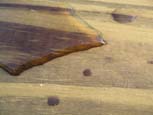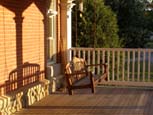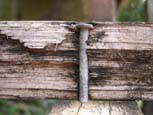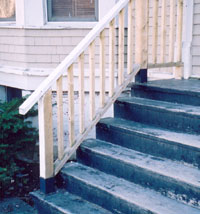Annual Deck Maintenance Checklist
Follow this annual deck maintenance schedule for a healthy deck.
Below is a guide for deck maintenance that covers all the crucial areas. It is intended to help you keep your efforts to a minimum rather than embark on a costly and timely overhaul.
For many areas warm weather only lasts for about six months of the year. Which means during the other six months your deck is facing the harsh elements that come with the climatic changes from summer to winter.
That also means to preserve your wooden deck you will have to maintain it each year in some way.
Depending on your climatic conditions, the causes of deterioration may vary but generally fall within the following sources. Be sure to focus your annual deck maintenance strategy accordingly.
Causes of Deterioration on Decks

The most common source of deterioration of
decks is water. Moisture causes the wood to expand and when it dries out
it contracts.
This can cause fasteners to pop and boards to warp, crack and split. If the deck remains constantly wet, a perfect environment exists for fungus and bacteria to establish itself and that is when rot begins. In a worst-case scenario, wet rot will result in wood members turning to mush over time.
Preventing this can be as simple as sweeping your deck regularly, clearing away puddles, dirt and leaves that retain moisture and do not dry out easily.

Sun is also a cause of deterioration to decks. Ultraviolet rays can break down the bonds between wood cells.
Fortunately, sun damage is not as serious as water damage because the rays only penetrate about 1/100th of an inch into the wood, really only affecting the surface.
The interesting thing is that this damaged surface protects the healthy wood below and if you sand it away the fresh wood exposed will become damaged. So, the best deck maintenance for a wood deck in a sunny area is a good coat of sealant or stain.
Insects can also cause serious damage to decks depending on your area.
Cedar and redwood are insect resistant but not insect proof. There is a difference. The best material for decking that is near soil and therefore insects is pressure and marine treated lumber.
Inspect your deck

At the beginning of each season be sure to conduct a thorough inspection of your deck.
An annual deck maintenance check includes walking around the deck to listen for squeaks. Try to feel soft spots or sagging areas.
Take a screwdriver and use it to physically pick or apply pressure to key components of the deck. Wood gets soft as it begins to rot and poking boards with a screwdriver will reveal these tell-tale signs.
Check all areas where there is direct wood to wood contact. We have mentioned this in other articles but it is even more relevant when it comes to doing the annual check up.
Examine Where Deck Boards Contact Joists
Check where joists contact beams and where the beams contact posts.
Annual deck maintenance is not complete without examining the posts and concrete footing contact points as these areas are particularly prone to moisture.
Check the ledger board where the deck connects to the house. Check the bottom of the stair stringers where contact is made with the ground or landing area.
Take note of areas that are showing water stains as these areas are telling you they received constant moisture and have potential for future problems.
If the area is open grain and facing up to the elements, it will suck water in via capillary action very effectively. After all that's how trees live. But even for any piece of dimensional lumber regardless of whether it is standing vertical or laying flat, the "infrastructure" is still there, so watch out.
These are critical areas to inspect to maintain the health of your wooden deck.
Replace Rotting Boards

This requires a bit of a surgical approach sometimes as you may have to only remove one rotting board tucked in tightly among other deck boards.
A circular saw and a sharp chisel are required for this kind of work. The saw will not entirely cut across the decking without damaging the next board. Use the sharp chisel to finish the cut.
Check Your Stairs

Deck stairs tend to be susceptible to rot in a
couple of key areas - the stringer tread connection points, and the
stringer landing points.
The end grain of the stair treads can soak up water in a hurry depending on how you have configured the tread stringer connection.
The stringer itself is also susceptible to rot at the foot where it contacts the landing, and the end grain is very vulnerable to soaking up water like a straw.
Proper deck maintenance involves checking the health of the stringers and elevating them somewhat off the landing.
Do a Bit at a Time Or a Lot All at Once
Annual deck maintenance should be an annual routine. It will help you keep on top of things and then you will never have to do a major overhaul.
If you incorporate annual deck maintenance into your routine, you will spend a little extra time each spring or fall maintaining it but more more time enjoying it!
Home > Cleaning Wood Decks > Annual Deck Maintenance


























